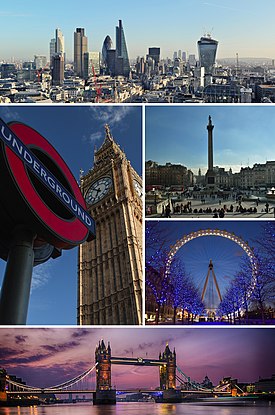
Back Лондон Abkhazian London ACE Лондон ADY Londen Afrikaans London ALS ለንደን Amharic London AMI Londres AN Lunden ANG लंदन ANP

London is the capital of the United Kingdom (UK), and its largest city.[6]
It is also the city with the highest population in the UK. The population is just under 9 million.[7] The city is the largest in western Europe by population and area.
On the Thames, London has been a central city since it was founded by the Romans two millennia ago as Londinium.[8] The Romans bridged the river Thames and built a road network to connect Londinium with the rest of the country.[9]
London's original city centre, the City of London is England's smallest city. In 2011 it had 7,375 inhabitants on an area of 1.12 sq mi (2.90 km2). The term "London" is used for the urban region which developed around this city centre. This area forms the region of London, the Greater London administrative unit led by the Mayor of London and the London Assembly.
London is one of the world's most important political, economic and cultural centres.[10] London was the capital of the British Empire and so for almost three centuries the centre of power for large parts of the world.
The city has about 9.1 million inhabitants (2018). If one counts the entire metropolitan area of London (London Metropolitan Area), it has about 15 million people. The climate is moderate.
- ↑ Number 1 Poultry (ONE 94), Museum of London Archaeology, 2013. Archaeology Data Service, The University of York.
- ↑ "London weather map". The Met Office. Archived from the original on 3 August 2018. Retrieved 26 August 2018.
- ↑ "Metropolitan Area Populations". Eurostat. 18 June 2019. Retrieved 4 December 2019.
- ↑ "Regional economic activity by gross domestic product, UK: 1998 to 2018". ons.gov.uk.
- ↑ Sub-national HDI. "Area Database - Global Data Lab". hdi.globaldatalab.org.
- ↑ Technically, England does not have a capital because Parliament is for the whole United Kingdom. Pearsall, Judy & Trumble, Bill, eds. 2002. The Oxford English Reference Dictionary (2nd, rev ed). Oxford University Press. ISBN 978-0198606529
- ↑ Office for National Statistics. [1]
- ↑ Perring, Dominic 1991. Roman London. London: Routledge. ISBN 978-0-203-23133-3
- ↑ Museum of London. [2]
- ↑ Leading European cities by gross domestic product in 2017/18. [3]



